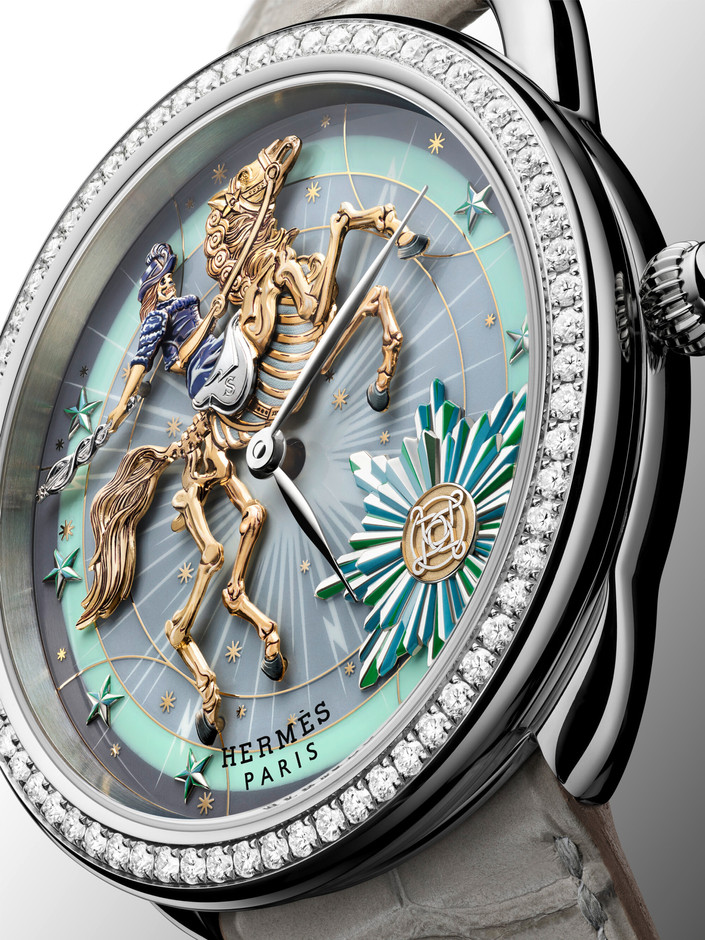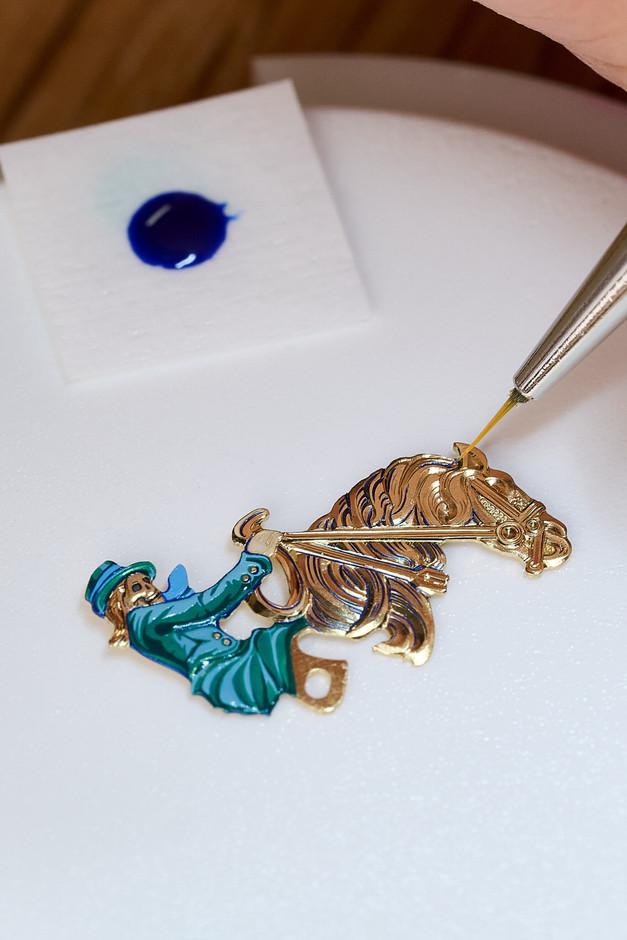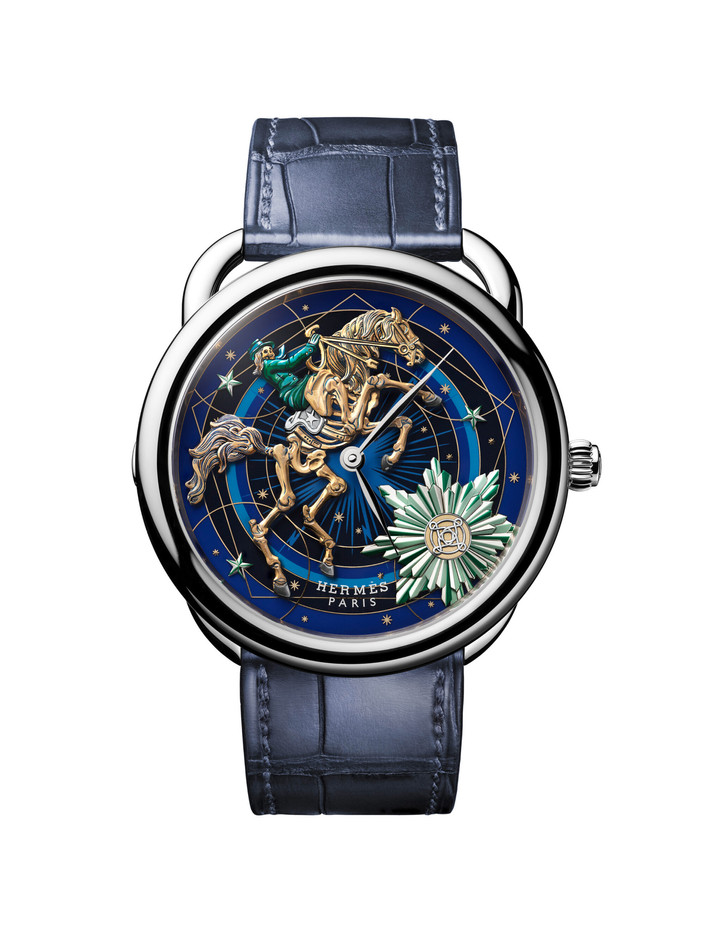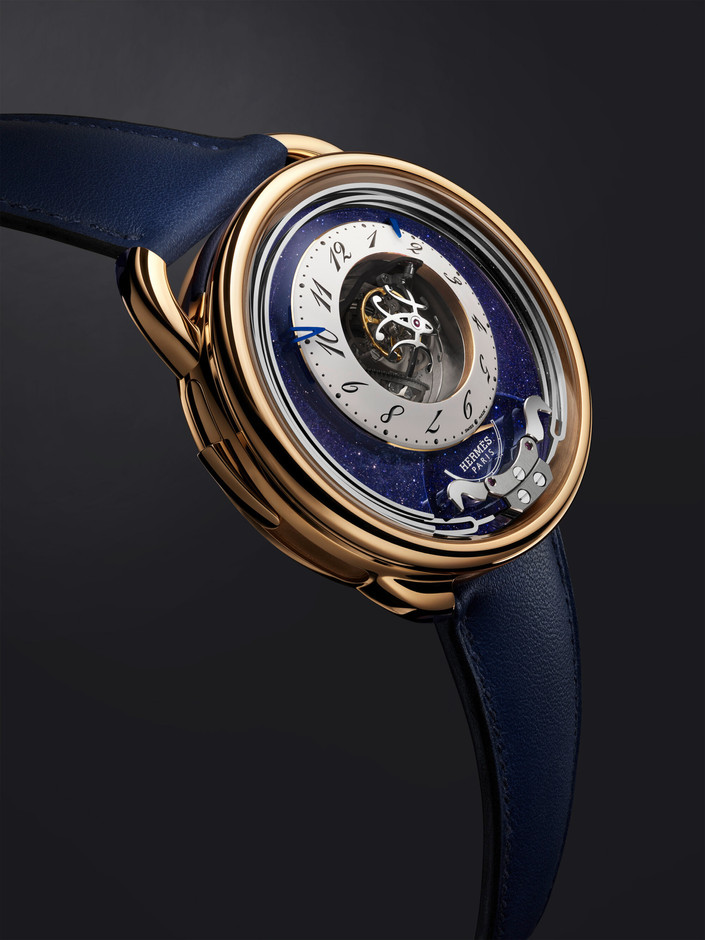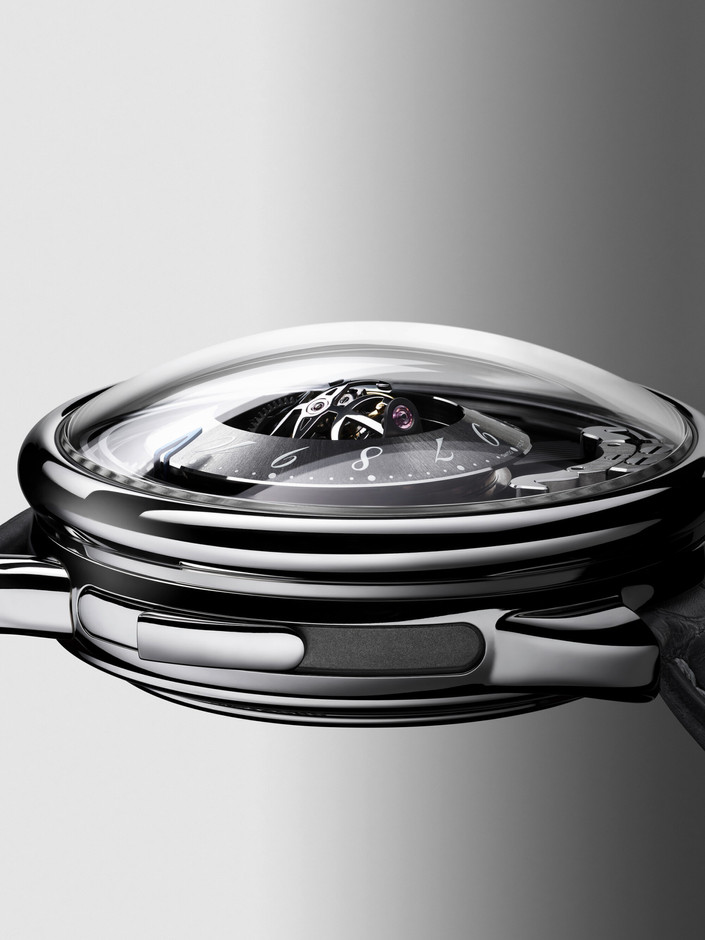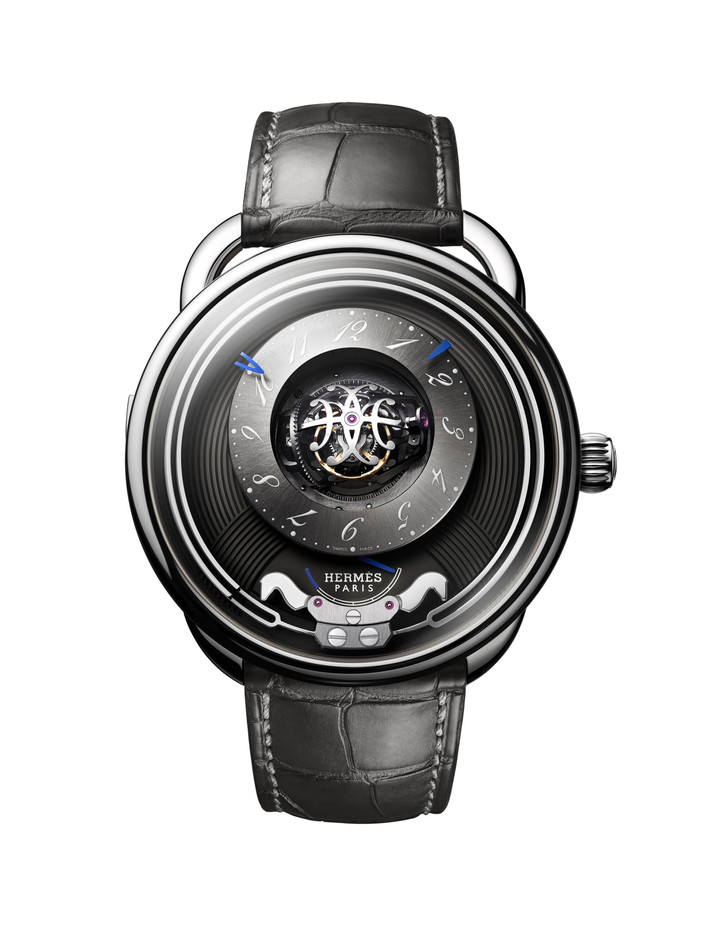Marc Fassone: Hermès is a house with many professions--16 to be precise--including watchmaking. What is your guiding principle in this particular business?
Philippe Delhotal: Time. We reinterpret time in our own way. Take the Arceau Le temps suspendu model: you press a button and time stops. Literally. No watchmaker stops time. Instead, they try to cut seconds in half... The same goes for the Arceau L’heure de la lune model. All the great watchmakers have moon phases. With the simultaneous display of the phases of the moon in the northern and southern hemispheres, our approach has been radically different.
Our watchmaking business is based on four pillars: traditional collector’s watches such as the Arceau, the Cape Cod and the Heure H; watches with complications and grand complications; watches for craftsmen, for which we work with an international network of craftsmen; and jewellery watches. What all these pillars have in common is the expression of original, offbeat creativity. Hermès is about taking a step to the side, about the unexpected, the grain of sand. The objects you buy at Hermès are different, and that’s why people come to us. If we did what other watchmakers do, we wouldn’t be here today.
The latest Hermès watch is the Hermès Cut. How do you create such a watch today? Where did the inspiration come from?
The Hermès Cut came three years after the launch of the Hermès H08, the company’s first sports watch. A sports watch is a watch that allows you to practise sport. A sports lifestyle rather than a sports competition. We didn’t have an equivalent in our women’s collection. We thought it would be a good idea to fill the gap.
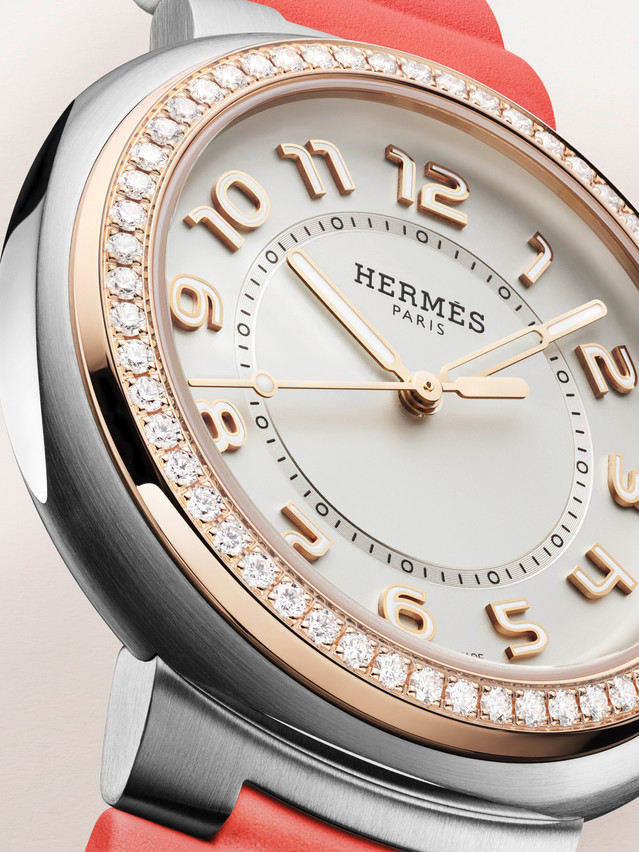
The Cut--shown here in diamonds, steel and rose gold--is on sale exclusively in Hermès boutiques. Shown here is the Arceau Chorus Stellarum. Photo: Hermès
The question of shape soon arose, the eternal problem. Shape is Hermès’ vocabulary. We opted for a particular shape, neither round nor oval, which we cut. This creative gesture, which gives the watch its name, this cut on all four sides, reinforces the special character of the case. From a distance, it appears round, but the closer you get, the more you discover its particular shape. It is this ambiguity of shape that gives the watch its unique character.
We have also moved the crown from its usual position at 3 o’clock to between 1 and 2 o’clock to preserve the balance and harmony of the shape, to preserve this perfect and special shape. The work on the dial is also important. We chose brass with different treatments and we worked on the typography. The typography was built around the shape of the case to create a real coherence. We took stylistic elements from the shape of the watch and integrated them into the dial.
How long did it take you to create this model?
Between the first sketch and the launch, it took about three and a half years. And of course there were several trials. Launching a new model, and a new shape at that, when many people are riding the vintage wave and prefer to bring a piece from their catalogue up to date, is a risk. We are a design house. Creation is our DNA! Even so, we launched two special shapes three years apart, the Hermès H08 and the Hermès Cut...
There’s always a risk of making a mistake. That’s part of the exercise. The creative process is a long road, with doubts, trials, iterations and even stops. When you’re not convinced, you have to know when to stop. I’m not just talking about watches, I’m talking about objects in general.
You mentioned DNA. How can you tell that this watch is a Hermès just by looking at it?
I’d like to say by the simplicity of the object and its particular shape. The Hermès Cut combines modernity and simplicity. It was for the sake of simplicity that we didn’t put a date window, so as not to unbalance the harmony of the round hours. In any case, everyone knows the date. It’s not necessarily an essential indication these days.
We preferred to play the aesthetic card and retain this purity and elegance. I often say that at Hermès, we prefer to remove things rather than add them. And I insist on the fact that it is its particular shape that gives this watch its expression. The shaped watch is a true Hermès signature. We work on the shape of all our watches.
How has the Hermès Cut been received, and will it become a permanent addition to your range?
It has been very well received, the feedback has been positive and sales have been very good despite the economic climate.
But will it become an icon, a watch that will last like the Arceau or the Cape Cod? There are lots of factors that determine whether a watch works or not. You have to be patient and wait three or ten years. Today, people are impatient when a product is launched. We want to know whether it works or not as quickly as possible, so that we can move on to something else. It’s the consequence of the consumer society we live in. When it comes to luxury products, I think it’s better to have the wisdom and patience to let things take their course.
With the Hermès Cut, we wanted to create something timeless. With a touch of mischief thanks to the interchangeable straps--one in metal and eight in rubber in different colours--which allow it to change face quickly. We wanted a watch with a certain versatility. That’s why we equipped it with a system of interchangeable straps that’s quick and easy. A first for the company in such a simple configuration: all you have to do is press a little button and it’s done. We have patented the system.
At Hermès, we take things lightly but seriously.
What are its technical characteristics?
The Hermès Cut is 36mm in diameter. It’s a women's watch, but it can also be worn by men with small wrists. In the 1980s, men’s sizes were 36-37 mm. Only tool watches, such as the Speedmaster, went beyond this, because they were equipped with mechanical movements that required them to be large. Then came the fashion for oversized timepieces. Now we’re back to it. Having an alarm clock on your wrist, I find a bit difficult... But it’s a choice.
The Hermès Cut is also our first ladies’ watch with an in-house manufactured automatic movement. It’s a movement manufactured by Vaucher Manufacture Fleurier, a company in which we have a 25% stake. The power reserve is around 50 hours.
What is a customer looking for when buying a Hermès Cut?
She’s looking for a comfortable, solid, everyday watch. The Hermès Cut is the watch for the active woman.
What is a luxury watch today?
A luxury watch is more than a watch, it’s an object, an object that is part of a history, it’s the translation of a history of watchmaking and knowhow. When we talk about luxury watches, we think of the manufactures and all the people involved in making them. This represents a real value, a creative value, a manufacturing value, a design value, a craft value and a transmission value. And this value will endure over time. A luxury watch is not necessarily a name that makes people dream. Nor is it an object that necessarily has to be expensive. There are objects that are handmade, that are very beautiful, but that are not necessarily very expensive, even though they have a history that allows them to exist for a time.
I’m not in phase with these references to brands and prices as absolute criteria. For me, a craftsman or designer can make a luxury object if he spends time on it and has the love to do so... Work, time--especially time--materials and history are the essential components of luxury. With our consumer society, luxury has lost some of its meaning. Hermès is a house of design and craftsmanship that creates functional, long-lasting objects. An object can be a car, an armchair, a plate, a bag or a watch. And in our company, we never do things at random. There’s always something behind it.
Is luxury a form of elitism?
Just because you wear luxury items doesn;t mean it's necessarily elitist. You may come across people in the street who aren’t wearing designer clothes, but who are wearing clothes made from noble materials and showing real craftsmanship. It’s an item for you and it’s your luxury.
That’s what luxury watches are all about. It’s true that watches are often branded and categorised... There are the manufacturers, there are the startups that arrived later, there are also the creatives, the new watchmakers... There’s a whole universe around the watch that’s vast enough for everyone to be able to define their luxury as they wish. If you want to buy a watch from a young designer because you like it, because you think it’s valuable, but it’s not branded, that’s not a problem. That’s why the perception of luxury is so different, depending on the individual and the culture.
It took you just under four years to design the Hermès Cut. In four years, we'll be in 2028, one hundred years after the launch of your first timepiece. Are you planning anything special for this anniversary?
Hermès is not in the commemorative business. Above all, we create watches because we want to amaze our customers. And also, I admit, to please ourselves. At Hermès, we take things lightly and seriously. We enjoy ourselves, of course, and we try to tell a good story, because, in the end, our objects are only what we tell them to be.
Arceau Chorus Stellarum
Hermès had three of its models selected to compete in the Geneva Watchmaking Grand Prix: the Cut, the Arceau Chorus Stellarum and the Arceau Duc Attelé. The Arceau Chorus Stellarum will compete in the Métiers d’art category. The dial is inspired by the Chorus Stellarum square designed by Daiske Nomura (€155,000).
Arceau Duc Attelé
The Arceau Duc Attelé is perhaps the most complex watch ever produced by Hermès. It features a minute repeater with a diapason gong and a triple-axis tourbillon. It will compete in the Mechanical Exception category. Twenty-four pieces were produced (€400,000).
This article was written in for the , published on 23 October. The content is produced exclusively for the magazine. It is published on the website as a contribution to the complete Paperjam archive. .
Is your company a member of the Paperjam Business Club? You can request a subscription in your name. Let us know via


